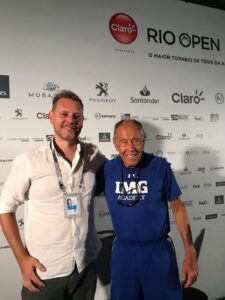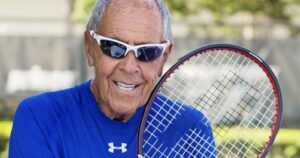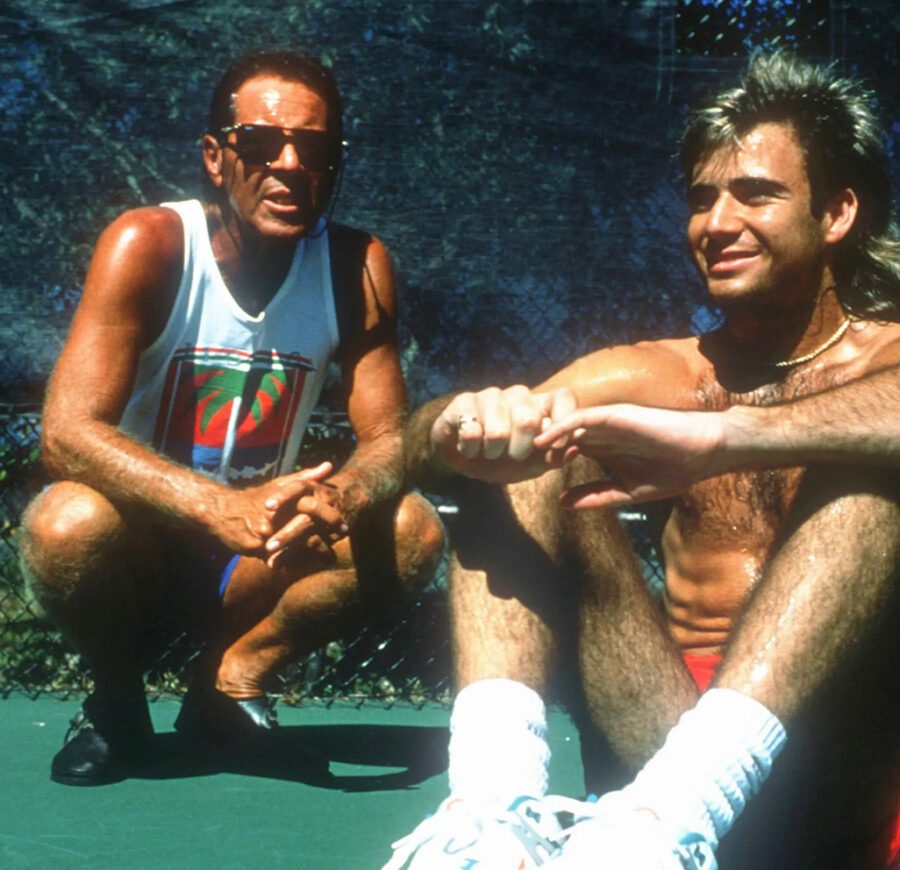The tennis of the last four decades would be different without Nick Bollettieri, who died on December 4th 2022 at the age of 91.
When it came to having a conversation about tennis, Bollettieri was one of the most interesting people you could meet. He knew a lot, a great deal, but he also talked about it with passion and joy.
This unpublished interview was conducted in February 2019 in Rio de Janeiro during the Rio Open.
**************************************
The American needed just one sentence to understand the secret of his success: “Age is numbers, just numbers. To me, I’m a young guy”.
“Del Potro is like the Statue of Liberty!” he said during a stretch of the interview at the Brazilian tournament. The conversation was a true review of tennis in the ’80s and ’90s, his most influential eras. In the interview, Bollettieri revealed some of the secrets of the formula that allowed him to bring success to so many players, from Andre Agassi and Anna Kournikova to Marcelo Rios and Boris Becker, through Jim Courier, Monica Seles, Maria Sharapova or the Williams sisters.
The eternally tanned Nick made a joke about the strong Brazilian heat: “I was in the sun for ten minutes and I had to leave… It’s the first time in my life!
– The tennis world is wondering: What is Bollettieri doing, why is he still working at his 80’s?
– If you paid all the bills I have to pay, you’d still be working… (laughs) Why? Because age is numbers, just numbers. For me, I’m a young guy. I love to work, I don’t make excuses. We have with my wife two children adopted from Ethiopia. And one of my sons once asked my wife why she looked at me so much in the mirror. “Because daddy loves himself,” she replied. I am also very proud to have become, two years ago, the first white person to be nominated for the Black Hall of Fame. So my Ethiopian son says to me: “Dad, you have to work a little bit harder on your tan.
– It’s been many years in tennis… What do you like about the sport today?
– What I like is that today you can dock at all ports, there is no single way of playing. The one-handed backhand is back, you see more serve and volley. Today’s tennis forces you to be able to do a little bit of everything. And if you have the slightest weakness, your opponent will exploit it until he beats you.
– And what do you see that you can’t take anymore?
– Sometimes I see players who are losing 6-0, 5-0, 40-0 and I think it’s not over until it’s over. With the amount of money that is being handed out in tennis today, you should always perform, especially thinking about people who pay expensive entry fees and travel from far away to go to tournaments. What is expected of players then is to give their all, to sign autographs for kids who wait for hours, to participate in chats… Other than that, I think the sport is in good health. It could be better, yes, it can always be better. But we have to give everything to tennis, we owe it a lot.
– You just mentioned the one-handed backhand, but you became famous for developing players who hit with both hands. Do you really like the one-handed backhand?
– If you ask me, I think the two-handed backhand has more benefits. But look at Tommy Haas, what a beautiful one-handed backhand, and think about Jimmy Arias: if his father had let me train him with a two-handed backhand when Jimmy was a kid, with that powerful forehand he had, he would have won a lot more. When you work with young players you don’t have to tell them if it’s a two-handed or a one-handed, you have to see what they do naturally.
– What a player from the Bollettieri factory always had was a very powerful forehand. Why?
– Because that’s the weapon I think you have to have. When Jimmy Arias came to the Colony Beach Hotel in the late ’70s he was a tiny kid from New York. I put him on court 3 with a big guy, the way he hit it, the way he jumped! I said to myself: that’s a Bollettieri forehand. And Jimmy opened a new era of power in tennis. Grips are totally different today, a player can’t succeed with an eastern grip forehand. You need one that goes from western to semi western. The eastern or continental is for slice, drop or serve, but for a good forehand you need a strong grip.
– Federer and Nadal… are they eternal?
– Federer can be explained by the fact that he is a champion in everything he does. The strength of his family, what he does for the sport… Everything. And Nadal… Nadal is… an animal! An animal… What you have to respect about him is that, no matter where the ball is, he’s going to get there and he’s going to hit it.
– Do you like Nadal’s forehand? It’s not exactly the Bollettieri model…
– No, it’s not. But look at the results! Coaches shouldn’t make all players play the same. Look at Brad Gilbert, his shots were so horrible that I had to put on my glasses. And yet: number four in the world, winner over Boris Becker and Andre Agassi. The game may not have been aesthetically pleasing, but Gilbert was an incredible player.

– You had the experience of working for a few months with Marcelo Rios, what was that like?
– (loses, for the first time in the interview, any hint of a smile) Very, very different. He had the greatest talent I’ve ever seen in a player in 60 years of coaching. He worked hard in the gym, hard on the court, but he didn’t respect the game, he didn’t respect the kids, he didn’t spend time with them. He didn’t do much for the sport off the court, and that was a shame.
– Did he respect the coach?
– (he thinks) Yes, he was correct on the court. He respected the coach and he works a lot on the physical side.
– But you didn’t like his attitude off the court.
– No, I didn’t like it. And, actually, that attitude hurt him. He probably should have had more respect for the players on the circuit, for the kids who waited for hours for him to sign autographs. I think that was bad for his career, I think that, with a different attitude, Marcelo Rios could have been number one for many years.
– The problem then was in his attitude.
– It was right here (points to his head). It was in the way he approached life.
– And Kournikova?
– She was very talented, but she couldn’t win a single tournament and had serious problems with her serve.
– What was wrong with her?
– She had all the talent in the world, but her mother wouldn’t let me change her forehand. The backhand was superior, the volley was excellent and she was a wonderful girl, but she had no forehand. And the mother wouldn’t let me change it… And when a mother says no, she says no.
– Who was more talented, Kournikova or Sharapova?
– If we talk about natural talent, I think Anna. Maria is the perfect example of a hard worker. What she worked! She is pure business, she works as much as it takes. And her attitude is incredible, she doesn’t give up until she is defeated. But things were not easy for Maria, and she suffered a lot of injuries, four or five. She’s a girl who works really hard….
– Of the new generation, the one that is supposed to replace Nadal, Federer and Djokovic, who catches your eye the most?
– The German, Zverev. He should be less angry, he’s a young guy and he’s always looking for support among his own in the stands. But he has tremendous talent.
– What do you remember about Gabriela Sabatini?
– A beauty! How to deny that, beautiful and with beautiful strokes! Her whole style was beautiful.
– And her game?
– I think she probably could have forced more, attacked a bit more. Had she had a powerful punch, a big weapon, like a good right hand, she would have done much more.
– Well, he actually had an unusual weapon, his backhand.
– That’s right! Yes, that’s right. And let’s not forget that in those years there was Steffi (Graf).
– Like Sharapova, Sabatini had major problems with the serve. Is that shot so complicated, can’t it be relearned?
– It’s not about learning how to serve well. There are a lot of people who do it naturally… But I think if I had a girl today who was having trouble serving, I would cut her in half, instead of making her wait so long for the ball. I judge a player by two measures: the second serve and the return. That gives me a very clear message about the player.










